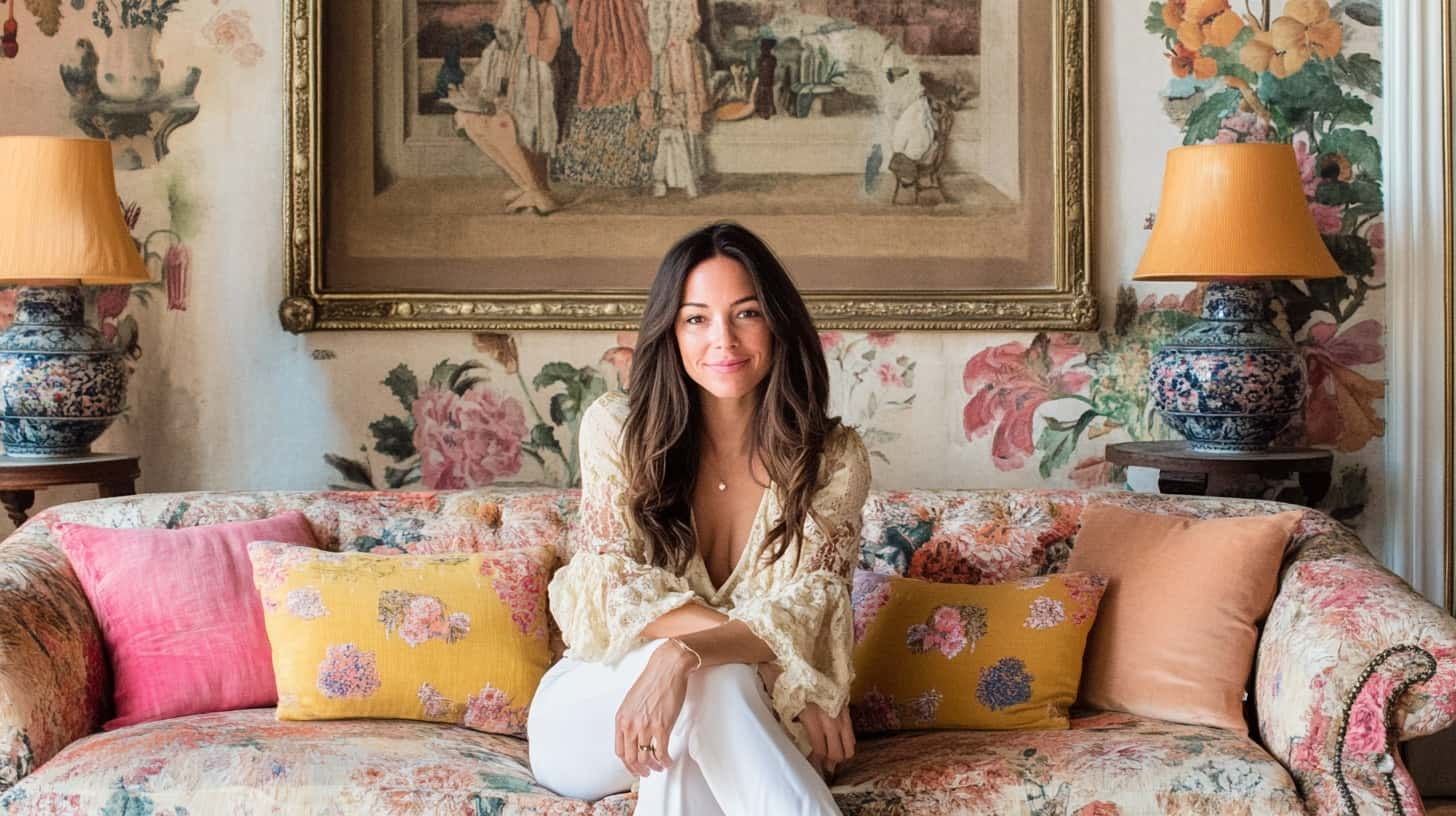To embrace maximalism in decor, start by choosing a vibrant color palette filled with bold hues and complementing accents. Mix patterns and textures confidently, combining large florals with geometric prints and rich materials like velvet and metal finishes. Incorporate eclectic art and decorative objects to express personality and create focal points. Balance these bold elements carefully to maintain harmony. Keep exploring styles and ideas to refine your space into a lively, personalized masterpiece.
Key Takeaways
- Combine bold, contrasting colors to create a vibrant, energetic environment that reflects personality and style.
- Mix multiple patterns and textures purposefully to add visual interest and depth without overwhelming the space.
- Curate diverse decorative objects and artwork that express individuality and serve as focal points.
- Balance busy elements with neutral tones and softer hues to maintain harmony and prevent chaos.
- Layer and experiment with materials, finishes, and accessories to develop a rich, dynamic, and personalized decor.
Understanding the Principles of Maximalism

Maximalism in decor is all about embracing boldness and personality in your space, rather than sticking to minimal or subdued styles. You’ll want to mix textures, patterns, and colors to create a lively, dynamic environment. The key principle is to celebrate abundance, not restraint. Layer different elements—like rugs, artwork, and furniture—to add depth and visual interest. Don’t shy away from making daring choices; instead, embrace contrasts and unexpected combinations. Personal expression is central, so your space reflects your unique taste and stories. While it might seem overwhelming at first, the goal is to create a space that feels vibrant, energetic, and authentic. Maximalism isn’t about clutter but about deliberate, thoughtful curation of diverse, eye-catching pieces. Embracing personality traits and individual stories can enhance the authenticity and emotional resonance of your decor. Incorporating design methodologies like layering and contrast can help achieve a cohesive yet bold look. Additionally, understanding the importance of decor styles can help you balance different elements effectively. To create harmony amidst the abundance, consider integrating interior design principles that guide the arrangement and selection of bold elements. For example, implementing self watering plant pots can add both aesthetic appeal and practicality to your decor.
Choosing a Vibrant Color Palette
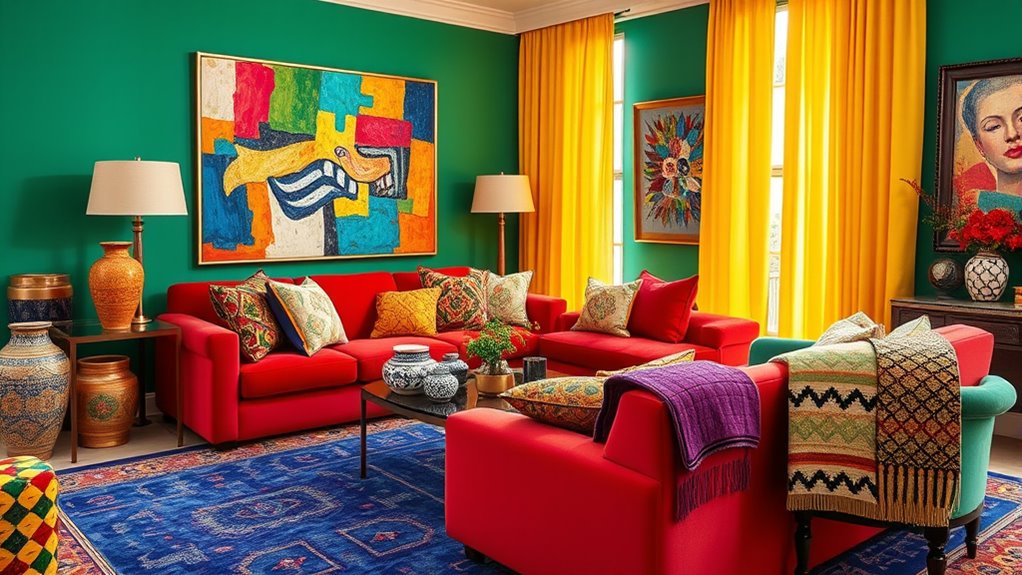
You can create a striking look by combining bold color combinations that reflect your personality. To keep the space balanced, consider how bright hues interact and complement each other. Using an accent wall is a smart way to add vibrancy without overwhelming the room.
Bold Color Combinations
Choosing a vibrant color palette is essential for creating a bold, energetic space that engages attention. To achieve striking color combinations, start with a dominant hue that sets the tone—think rich reds, deep blues, or vibrant yellows. Then, add accent colors that contrast or complement your main shade, such as pairing emerald green with blush pink or navy with mustard. Don’t be afraid to mix warm and cool tones for dynamic visual interest. Use bold patterns and layering to enhance the effect, ensuring colors work harmoniously rather than clash. Remember, the key is confidence; embrace your favorite hues and combine them daringly. A well-planned palette transforms your space into a lively, fascinating environment that reflects your personality and love of maximalist decor. Incorporating a variety of textures and color combinations can further amplify the visual impact, especially when considering the color harmony principles that guide successful maximalist designs. Additionally, understanding the role of attention can help you focus on creating focal points that draw the eye and add depth to your decor. Moreover, integrating vetted plant options into your space can introduce natural elements that enhance the overall aesthetic and foster a lively atmosphere.
Balancing Bright Hues
While vibrant hues can energize a space, balancing these bright colors is key to creating a harmonious environment. You want bold shades to make a statement without overwhelming the room. Start by choosing a dominant color and use it sparingly alongside more neutral tones. Incorporate softer hues to tone down the intensity and provide visual relief. Use patterns and textures to break up large blocks of color and add depth. Keep the overall palette cohesive by sticking to a consistent color family or complementary shades. Remember, less is often more—avoid cluttering the space with too many competing colors. With thoughtful balancing, your vibrant palette will feel lively yet inviting, making your space both striking and comfortable. Additionally, understanding the effectiveness of glycolic acid can help you achieve a clear and radiant complexion that complements your bold decor choices. To enhance your overall design, consider exploring advanced techniques for balancing color and pattern to elevate your decor. Incorporate cybersecurity principles to protect your digital environment from potential threats, ensuring your creative space is safe and secure. Incorporating color psychology can also help you select hues that evoke the desired mood and atmosphere in your environment. Use neutral base colors to ground bright accents – Incorporate natural materials for warmth – Limit the number of bold hues in one room – Mix matte and glossy finishes for contrast – Step back regularly to assess color balance A well-curated color palette can also enhance city dynamic and promote a welcoming atmosphere in your home.
Accent Wall Strategies
Ever wondered how to make a bold statement with your walls? Choosing a vibrant color palette for your accent wall instantly draws attention and sets the tone for your space. Start by selecting a hue that complements your existing decor but stands out enough to create impact. Think rich jewel tones, fiery reds, or electric blues to embrace maximalism. Don’t be afraid to experiment with patterns or textured finishes alongside your color choice. Keep the surrounding walls neutral to let your accent wall shine. Use painter’s tape for clean lines or geometric shapes to add visual interest. Remember, the goal is to create a focal point that energizes your room without overwhelming it. Incorporating color psychology can significantly enhance the overall aesthetic and mood of your space. Understanding safe sleep environments and choosing colors that promote relaxation can help create a balanced and inviting atmosphere. Paying attention to dog names can inspire fun and lively themes for your decor accents, adding personality to your space. A carefully chosen vibrant palette transforms your space into a bold, cohesive statement.
Mixing and Matching Patterns With Confidence

Mixing and matching patterns might seem intimidating at first, but with a little confidence, it can become a fun and rewarding way to express your personal style. The key is to start small—combine two or three patterns that share a common color or theme. Trust your instincts and don’t be afraid to experiment. Keep the scale varied; pairing a large floral with a tiny geometric creates visual interest without overwhelming. Remember, contrast is your friend—mix soft and bold patterns to add depth. Ultimately, balance busy patterns with solid colors to prevent clutter. Here are some tips:
Start small, mix patterns with confidence, and balance bold with neutral for a stylish, cohesive look.
- Stick to a consistent color palette
- Mix different scales of patterns
- Use neutral tones to anchor bold prints
- Combine geometric and organic motifs
- Don’t shy away from unexpected pairings
Layering Textures for Depth and Interest

To create a rich, inviting space, you should mix different materials like velvet, leather, and wood. Varying surface finishes, such as matte and glossy, add even more visual interest. Combining these textures thoughtfully will give your decor depth and make every element stand out. Incorporating visual and auditory cues can also enhance the sensory experience, adding another layer of interest to your layered textures. Additionally, integrating elements with high fiber content can contribute to a tactile variety that enriches the overall sensory environment. Using hybrid materials that blend textures can further amplify the layered effect and create a dynamic, engaging aesthetic. Exploring remote hackathons can inspire innovative ways to approach interior design projects through collaborative and creative problem-solving.
Mixing Different Materials
Layering different materials in your decor adds both depth and visual interest, transforming a space from flat to fascinating. Mixing metals, woods, fabrics, and plastics creates a dynamic environment that keeps the eye moving. You might combine a velvet sofa with a sleek glass coffee table or add woven baskets alongside metallic accents. Using contrasting materials highlights each element’s unique qualities and keeps the room lively. Incorporating spiritual symbolism through color and material choices can also enhance the ambiance and personal meaning of your space. Additionally, understanding material durability helps in selecting pieces that will stand the test of time and maintain their visual appeal. Exploring biodiversity principles in material selection can inspire eco-friendly and sustainable decor choices that support environmental health. Don’t be afraid to experiment—pair rough textures like burlap with smooth silk or matte finishes with high gloss. This approach makes your space feel curated and personal. Remember, balance is key, so mix materials thoughtfully to avoid visual clutter. The goal is to create a layered, textured space that invites exploration and feels truly curated. Incorporating innovative design techniques can further elevate your decor and add a personalized touch, while considering the importance of pet-friendly materials can ensure your space remains safe and welcoming for your furry friends.
Varying Surface Finishes
Building on the idea of combining different materials, varying surface finishes adds another layer of visual interest to your decor. You can achieve this by mixing matte, gloss, satin, and textured finishes within a space. For example, pair a glossy ceramic vase with a matte-finish wall or a satin-finished wood table with rough, textured textiles. This contrast creates depth and draws attention to different elements. Don’t shy away from combining smooth surfaces with rough or tactile ones—it enhances the layered, maximalist vibe. You can also introduce finishes that catch light differently, like metallic accents or reflective surfaces, to add sparkle and movement. Varying surface finishes keeps your space dynamic, engaging, and full of personality, making every corner feel thoughtfully curated and lively. Incorporating surface finishes strategically can also help in creating designated zones and defining specific areas within your space.
Incorporating Art and Decorative Pieces
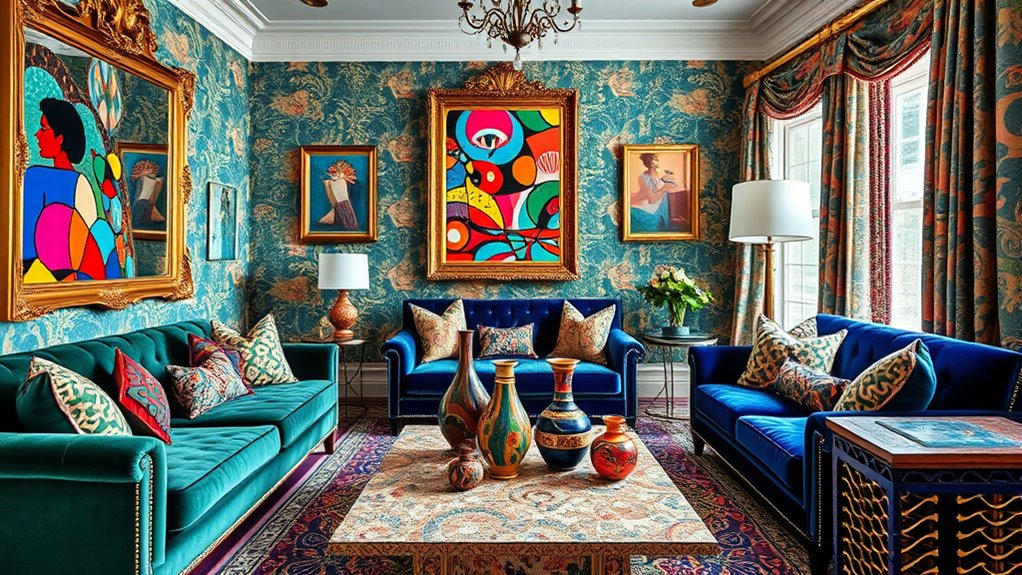
In a maximalist decor scheme, incorporating art and decorative pieces becomes an essential way to express personality and add visual interest. You want your space to tell a story, so choose vibrant artwork, eclectic sculptures, or vintage finds that resonate with your style. Layer different textures and sizes for depth, mixing paintings, prints, and framed photos. Don’t be afraid to combine unexpected pieces that spark conversation or evoke emotion. Display items prominently on walls, shelves, or mantels to create focal points. Remember, each piece should contribute to the overall bold aesthetic without overwhelming the space.
- Curate a gallery wall with colorful art
- Mix antique and modern decorative objects
- Use statement sculptures or vases
- Incorporate textured textiles with art
- Hang bold, eye-catching prints
Balancing Bold Elements for Cohesion
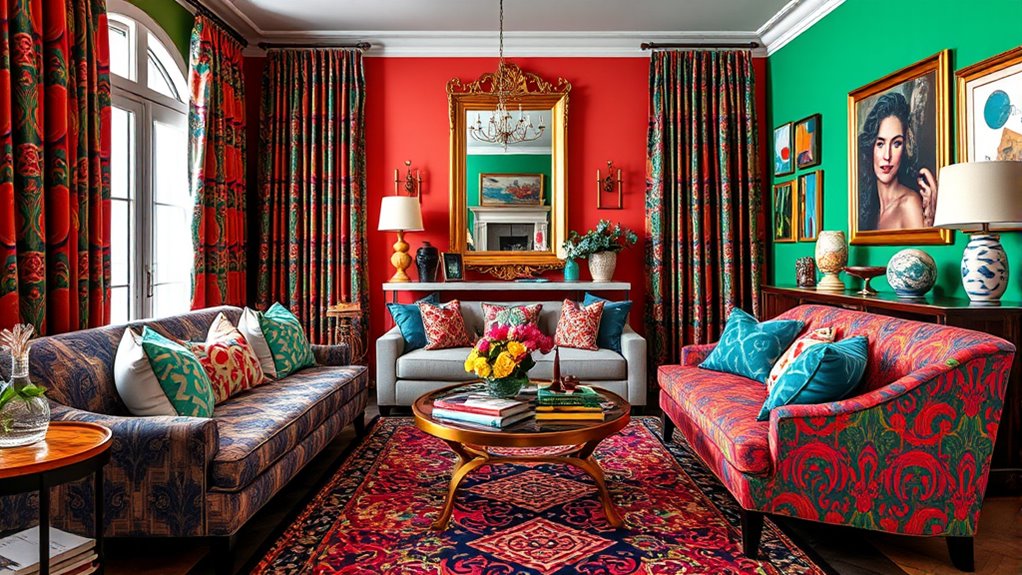
Achieving cohesion in a maximalist decor scheme requires thoughtfully balancing bold elements so they complement rather than compete with each other. Start by choosing a unifying color palette, even if your patterns and accents are diverse. Use repetition of colors or motifs to create visual harmony across different pieces. Incorporate grounding elements, like neutral furniture or subtle textures, to anchor the space and prevent overwhelming chaos. Vary the scale and placement of patterns so they don’t clash; mix large, bold prints with smaller, intricate details. Keep a clear focal point—such as a statement art piece or a vibrant piece of furniture—to guide the eye. By carefully balancing these elements, your space will feel lively yet cohesive, showcasing your personality without feeling chaotic.
Tips for Successfully Transitioning to Maximalist Decor
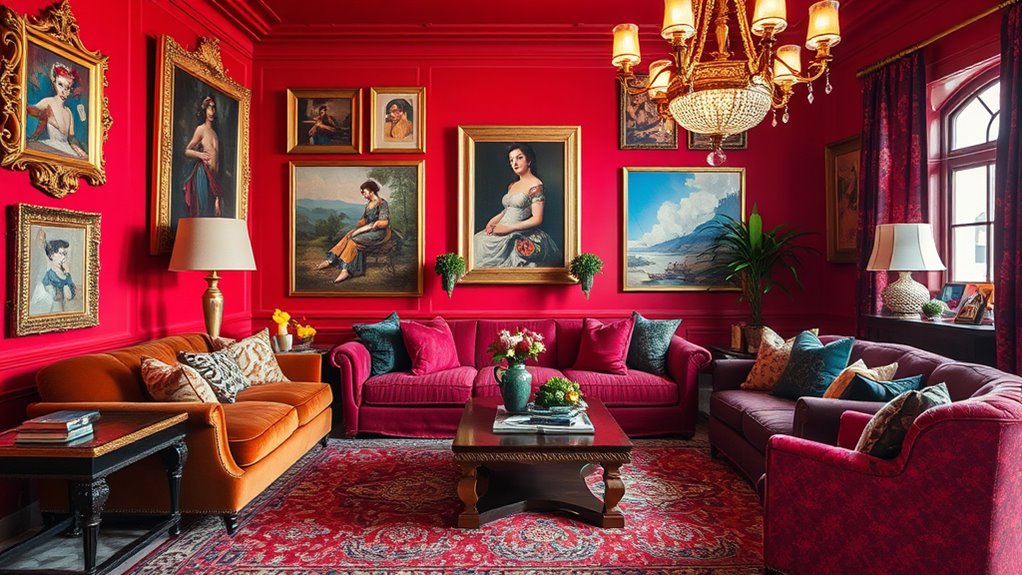
Moving to maximalist decor can feel overwhelming, but taking small, deliberate steps makes the process manageable. Start by decluttering your space to create a blank slate. Gradually introduce bold colors and patterns through accessories like cushions, rugs, or artwork. Mix different textures and styles intentionally to add depth. Don’t be afraid to experiment—swap out items or rearrange furniture until it feels right. Keep a balance by maintaining some neutral elements to prevent the space from feeling chaotic. Ultimately, trust your instincts; let your personality shine through the choices you make. Remember, maximalism is about expressing yourself boldly, so have fun with it and embrace the process of transformation.
Embrace maximalism by adding bold colors, mixing textures, and trusting your instincts to create a vibrant, personalized space.
- Start small with accessories and accents
- Mix and match patterns intentionally
- Use neutral tones to anchor bold elements
- Rearrange furniture for fresh perspectives
- Trust your instincts and have fun
Frequently Asked Questions
How Can Small Spaces Benefit From Maximalist Decor?
When you bring bold colors and patterns into small spaces, you create a lively, vibrant atmosphere that feels cozy yet energetic. It’s about making every inch count—layering textures and mixing patterns to add depth and personality. You can use statement pieces or colorful accessories to make the space feel larger and more inviting. Embracing this style helps you turn a compact area into a bold, expressive environment that reflects your personality.
What Are Common Mistakes to Avoid in Maximalist Decorating?
Imagine stacking too many vibrant patterns in your living room, creating chaos instead of charm. You should avoid overwhelming your space with excessive colors or conflicting designs, which can make it feel cluttered. Instead, balance bold patterns with neutral tones, and use one statement piece as a focal point. Keep your decor harmonious by mixing textures thoughtfully, ensuring your space feels lively yet cohesive.
How Do I Update Traditional Furniture for a Maximalist Look?
To update traditional furniture for a maximalist look, start by painting or upholstering pieces in bold, vibrant colors. Mix different patterns and textures to create visual interest, and incorporate eclectic accessories like layered rugs, art, and decorative objects. Don’t be afraid to combine vintage with contemporary styles. You want your furniture to stand out, so embrace the boldness and let your personality shine through each piece.
Can Maximalism Be Adapted for Minimalist or Modern Styles?
You might be surprised to find that maximalism can blend seamlessly with minimalist or modern styles. It’s about adding unexpected pops of color or patterns to create visual interest without cluttering. You can incorporate bold accessories or statement art pieces into a clean, simple space, making each element stand out. The key is balancing the bold with the understated, allowing your personality to shine through while maintaining a sleek, modern aesthetic.
What Accessories Best Complement Bold Colors and Patterns?
When choosing accessories for bold colors and patterns, you want pieces that enhance without overwhelming. Opt for simple, sleek items like solid-colored throw pillows, minimalistic vases, or understated artwork. These elements add balance and sophistication, allowing the vibrant hues and patterns to stand out. Remember, less is often more; select accessories that complement your bold decor without competing with it, creating a harmonious and inviting space.
Conclusion
So, go ahead and embrace the chaos of maximalism—you’ll love how your space feels alive and personal. Just remember, while mixing bold colors and patterns can seem daring, it’s all about finding that sweet spot where everything somehow works together. Ironically, the secret to success is often less about restraint and more about daring to go all in. After all, what’s life without a little chaos and a lot of personality?


